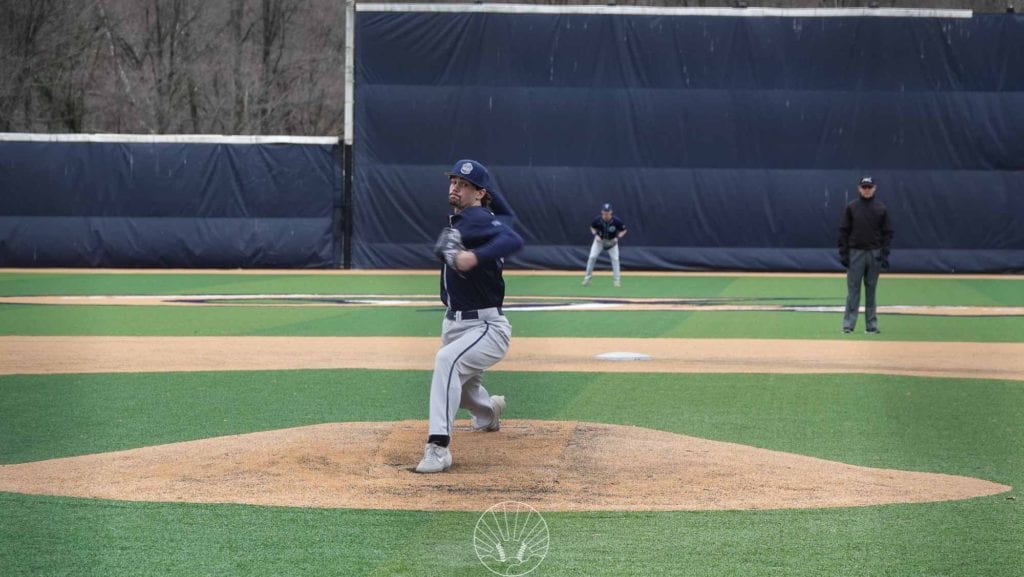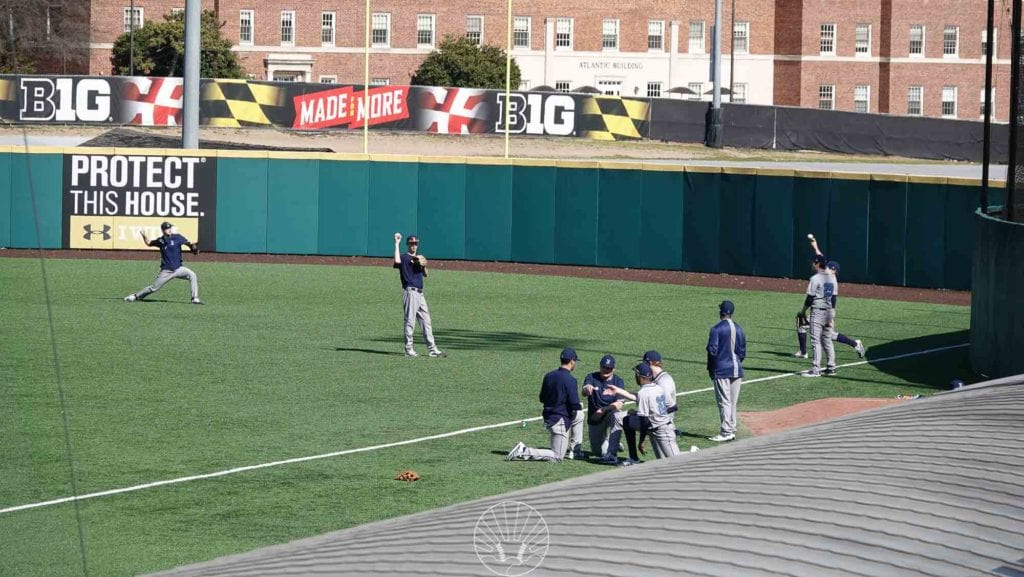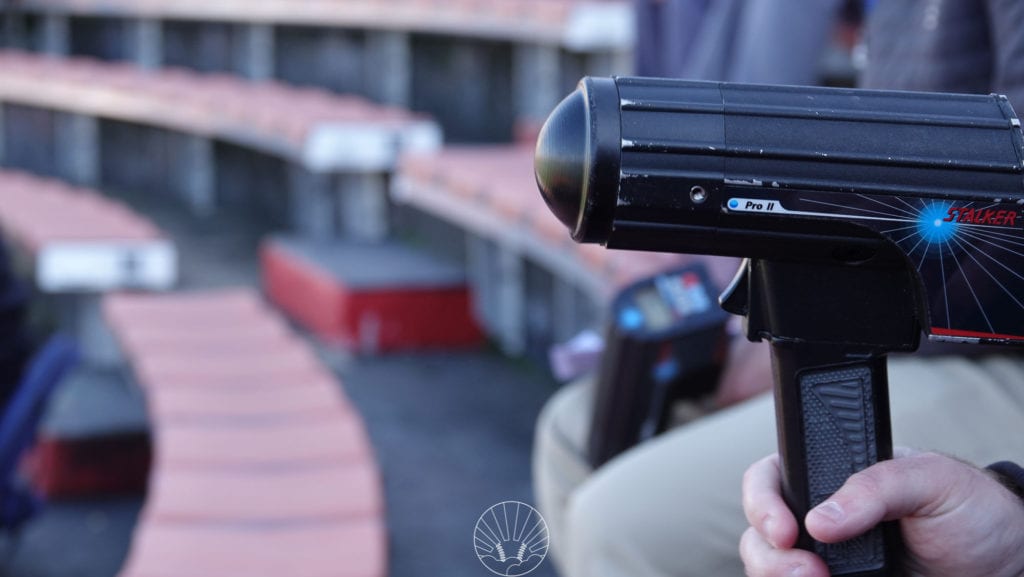*This article may contain product links which pay me a small commission if you make a purchase. Learn more.
Long toss is a hot topic in the baseball world. As more and more of us become exposed to the impressive distance of public long-tossers such as Trevor Bauer, a question arises: exactly how well does velocity correlate with distance? Does long toss predict throwing velocity?
Does Long Toss Predict Throwing Velocity?
With the Pitch F/X system now in all MLB ballparks, we are getting more of a glimpse into the role that spin rate plays on the flight of a thrown baseball. The arm speed of a pitcher is applied to the baseball as two products: linear velocity and spin (rotational velocity). Everyone talks about throwing velocity, but nobody seems interested in discussing spin velocity.

I’m a proponent of long toss as a training tool. But, even as a proponent, I’ve been asking myself if long toss distance correlates to velocity as strongly as some say. And, if not, what are the variables at play? In this article, we’ll look at some physics, discuss spin rate, and determine whether or not long toss is a good predictor of velocity.
Layman Baseball Flight Physics
Spin creates what is known as Magnus force. Magnus force is the force the spin produces perpendicular to the direction of flight. In the case of a curveball with topspin, Magnus force causes a downward break that deceives a hitter. In the case of a fastball, the backspin causes the pitch to resist gravity in proportion to its spin rate.
If spin is high enough to provide lift greater than the weight of the ball, it could make it rise. Though pitchers are not capable of producing enough spin to make a fastball rise, they are capable of reducing the ball’s effective gravitational weight.

Backspin in long toss produces lift, causing the ball to resist the force of gravity and fly further. At the same initial trajectory and velocity, a throw of higher spin rate will fly farther. Sidespin, another variable in the equation, reduces this effect of hang time by producing a lateral Magnus force, reducing the lift of the ball. Consequently:
Higher velocity, higher backspin, and reduced sidespin produce greater throwing distance.
For the purposes of this discussion, we will assume that sidespin stays constant along with wind, trajectory, grip (4-seam vs. 2-seam) and release height, isolating the variables of backspin and velocity. Dr. Alan Nathan of the University of Illinois, a baseball physics expert, created a batted and thrown ball trajectory tool that I used to calculate the flight of throws with different velocities and spin rates.
For comparison, I took spin rates of 1000rpm to 3500 rpm, which appears to be an acceptable range for most Major League pitchers, though few are capable of 3000+ rpm rates. The average RPM of Major Leaguers lies somewhere between 1200-2000rpm, according to an informal scouring of Brooksbaseball.net
What Is An Optimal Trajectory?

According to the trajectory calculator, maximal distance will be achieved at a launch angle of 30 degrees. Even one degree above or below this angle results in decreased distance.
For example, a throw of 90mph at 2000rpm achieves the following distances with alterations in trajectory:
- 30 degrees: 368 feet
- 35 degrees: 364 feet
- 40 degrees: 352 feet
Chart of Throwing Velocity vs Spin Rate
Next, I plugged in common velocity milestones and different spin rates in increments of 500rpm across the 1000-3500rpm spectrum. We got a distance value for each, and the results are interesting. Have a look:
| RPM/Velocity | 80mph | 85mph | 90mph | 92mph | 95mph | 98mph |
| 1000 rpm | 300 | 326 | 352 | 362 | 378 | 392 |
| 1500 rpm | 308 | 335 | 361 | 372 | 388 | 403 |
| 2000 rpm | 313 | 341 | 368 | 378 | 394 | 409 |
| 2500 rpm | 317 | 344 | 372 | 382 | 398 | 413 |
| 3000 rpm | 319 | 347 | 374 | 384 | 400 | 415 |
| 3500 rpm | 321 | 349 | 376 | 386 | 402 | 417 |
(Distance in Feet)
The data above was taken from Professor Nathan’s Baseball Trajectory Calculator.
For this experiment, parameters were set to:
- Launch angle: 30 degrees
- Release point: 6.5 feet
- Sidespin: 500rpm (the default value)
- Wind: 0mph
The Chart and Its Implications
If two throwers have the same release velocity but are at opposite ends of the spin continuum, their distances will vary by nearly 25 feet. This is a big discrepancy.
This means that pitchers can fall anywhere within a 3-5mph hour window of velocity (spin rate unknown). For example, a pitcher with a maximal throw of 400 feet could throw 95mph with a spin rate of 3000rpm. That same pitcher could reach 400 feet at less than 1500 rpm with velocity at 98mph. So, without knowing spin rate we can only predict velocity within this 3-5mph window. But, with most pitchers closer to the center of the bell curve, we’ll see most distance disparities in the 10-15 foot range, which correlates to a lesser velocity range of 2-3mph.
Below are some distances, with the low velocity number being of high spin (3000-3500rpm), and the high velocity number being at a low rate of spin (1000-1500rpm).
- 300ft: 77-80mph
- 325ft: 82-85mph
- 350ft: 85-90mph
- 375ft: 90-94mph
- 400ft: 95-99mph
So, Is Long Toss A Good Predictor of Velocity?
The short answer is that it does a good job of predicting long toss velocity. Predicting mound velocity, or even low-trajectory velocity, however, isn’t as certain because we don’t have a predictive model across trajectories. Some throwers may be more skilled at applying their maximum force downhill from a mound, while others may be able to apply maximum force at flat or high-angle trajectories. It’s something that is likely to be unique to the individual and subject to practice time at a given release angle.
Dr. Stuart McGill, in his book Ultimate Back Fitness and Performance, discusses how athletes of highly elastic, high-velocity sports create a unique “pulse” of force. Some athletes are naturally better at creating a force pulse than others, which explains why absolute strength, as shown in the weight room, isn’t always a great predictor of high velocity endeavors.
What this means is that athletes may be in great synchronicity during a specific task, but should they lose that synchronicity on a similar, but different task, their force pulse may change for the worse. This model helps explain why many position players can achieve higher velocities on flat ground (which they practice during games) than when asked to pitch. Pitchers are likely to achieve their highest velocities throwing from the mound.
It’s reasonable to assume that the more one long tosses, the better he becomes at producing a well-timed pulse of force that at the uphill release angle. These mechanics will be slightly different when throwing on a line, or on the mound. So, it would be hard to say how well absolute velocity translates given slight variations in mechanics and the pulsing produced by them.
Yet, because throwing a baseball at varying angles only involves slight variations in mechanics, it may be reasonable to assume that if a pitcher can produce a certain peak velocity during long toss, on the mound or on flat ground, he would be able to transfer it to the other throwing trajectories with additional practice.
It is unlikely that a pitcher would be losing more than a few percentage points of his maximum velocity from one release angle to the next. In my training facility, we have taken radar readings on hundreds of pitchers and we’ve found that velocity is very consistent across different release angles. The biggest variable we see is arm slot.
Does Arm Slot Impact Long Toss Potential?
Yes. Physics tells us that higher arm slots will produce less sidespin and more backspin, and thus farther throws. So, players with higher arm slots should throw consistently farther than those with lower arm slots, who will naturally produce higher sidespin and lower backspin rates.
For more on arm slot and what it means for your velocity potential, check out the video below:
Pitchers with low arm slots may fall well short of the predicted distance that we would expect from a pitcher of similar throwing velocity but who has a higher arm slot.
Takeaways Regarding Pitching Velocity & Long Toss
- For pitchers with a standard arm slot of ¾ or higher, we can predict their release velocity to a precision of 3-5mph without knowing their backspin rate.
- For throwers with lower arm slots, this range of possible velocities will expand compared to high arm slot throwers because backspin rates may be lower than the range shown in our chart. Sidearm pitchers, for example, might long toss with 0rpm of backspin, making their ball carry far less than other pitchers at the same throwing velocity.
- It is unknown how well maximum velocity transfers across different trajectory throws, but it is assumed that the more one practices at a given release angle, the more effective he will be at producing maximum velocity at that angle.
- We don’t know the effect of training at different release angles, as is common practice for a pitcher who will throw from the mound, flat ground and perform long toss all within a given week. But, from my firsthand radar research of pitchers, I have found it safe to infer that maximum velocity will be consistent, with only slight variations from one release angle to another.
Learn More About Throwing Velocity & Where it Comes From
If you want to improve your throwing velocity, check out the video below and definitely read my very thorough guide to pitching mechanics.
Be sure to check out Dr. Nathan’s work yourself on his website.
Long Toss and Pitching Velocity FAQ
Does long toss increase velocity?
Yes and no. Throwing in general is the main activity a pitcher needs to do consistently if he wants his velocity to increase over time. Long toss teaches lots of good things – how to use the legs, go uphill, stay closed, use the front side, and be accurate over long distances. But the stimulus of throwing a ball far doesn’t exactly lead to more velocity – it’s more of a display of the velocity you currently have today. A combination of throwing, weight training, arm strengthing, proper flexibility and mobility and explosive exercises will help increase velocity together.
How hard do you have to throw to throw 300 feet?
In the low-80s is a good estimate. Check out the velocity chart in this article that uses physics data from one of the world’s baseball physics experts, Dr. Alan Nathan. His calculator of fly ball distance is a great estimator, and it shows that somewhere between 77-82 is needed to throw approximately 300 feet.
Can you long toss every day?
No – two times per week is about right, with three being acceptable some of the time, as long as intensities aren’t max-effort. You can’t stress your arm out like crazy everyday, especially if you’re also pitching a few innings or bullpens each week, and are also playing catch. It’s good to throw 5-6 days per week, but some of those days needs to be low-intensity.
References:
Blewett, William. (2013) The Science of the Fastball. Jefferson, NC: McFarland & Co.
McGill, Stuart. (2004) Ultimate Back Fitness and Performance.
Nathan, Alan. (2012) Baseball Trajectory Calculator Retrieved from: http://baseball.physics.illinois.edu/trajectory-calculator.html
